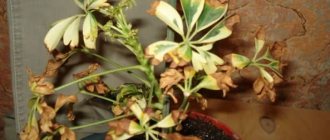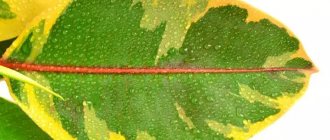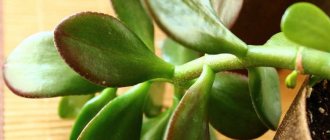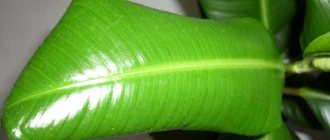Plants » Flowers
0
2347
Article rating
Kira Stoletova
When growing ficus plants at home, gardeners often encounter problems related to caring for home flowers. It is not uncommon for ficus leaves to fall off.
Causes of ficus leaves falling
The time is coming
For many ficus lovers, the period when the latter suddenly begins to shed its leaves comes as a complete surprise. They begin to look for the reasons that lead to the fact that the leaves turn red, darken to the color of rust, their tips turn inward, bend and deteriorate.
Thus, for the Benjamin (Impalce) flower and its curly variety Nitida, the slightest changes in the state of indoor comfort become the reason for the loss of leaves: a change in care methods, replanting, an attempt to propagate in winter or autumn.
Ficus, even with proper care, loses leaves every year; this is a natural process of changing leaves in winter. Falling occurs at the onset of the autumn-winter season. This is due to the aging of vegetation and the need for its renewal. Immediately with the arrival of cold weather, the leaves droop, become lethargic, turn yellow, curl and fall off. In winter, the leaves on the ficus fall off or do not dry out entirely, but only the lower ones, at the beginning of the trunk. With the onset of spring warmth, new and young ones will grow on the empty ficus trunk.
Temperature
The tree is very afraid of drafts and cold. Therefore, you should carefully ensure that the microclimate in the room is correct.
Here's what you need to consider:
- The optimal air temperature is 23–25 degrees.
- The plant can live in winter at temperatures up to 10 degrees. But it is better that it does not fall below 15 ºC.
- The temperature decrease should occur gradually. The best option is up to 0.5 degrees in 2-3 days.
- Exposure to drafts is not allowed. The room should be ventilated so that the ficus itself is protected from the wind.
- The flower will be very hot near the radiator.
Thus, it is necessary to calculate in advance where the ficus will be most comfortable.
Reference. This flower loves sunlight, and its leaves participate in photosynthesis. This means that for uniform photosynthesis you will have to move the pot periodically. But you should not move it often from place to place, this can also cause yellow leaves to appear.
Causes of leaf fall
If the ficus has dropped its leaves or they have drooped, withered, bent, curled up, turned yellow and brown, or fly off not only when the cold season sets in, the reasons lie in improper care: the home flower is missing something.
One of the most common reasons for leaf fall is a change in the climatic conditions in which the plant is accustomed to developing, which most often occurs during its propagation or transplantation.
Often, changing the location of a flower pot is a temporary phenomenon, so that a flower with curled leaf blades hangs down the foliage and then throws it off. In such a situation, it is quite possible to restore the former beautiful crown of the flower and root it before the leaves of the ficus fall off completely.
Among other reasons why ficus sheds its leaves, the most well-known in home floriculture are:
- excessive importance;
- sudden temperature changes and drafts,
- moving to new conditions immediately after transplantation,
- insufficient lighting,
- oversaturation of the soil layer with moisture,
- the presence of insectivorous parasites and fungal infections,
- soil contaminated with pesticides.
Spider mite
This is the enemy of most plants, and it can really destroy your green friend if action is not taken in time. Brown and gray spots appear on the leaves, and a thin cobweb is stretched between the leaves. If you look closely, you can see the bustle of small insects - spider mites. The reason for the appearance of these pests is heat and dry air. How to fight?
Treat the plant with an insecticide and then be sure to replant it. The pot must be new, the soil must be fried. Place the pot in another place, since the old one (in the smallest cracks) may contain spider mite eggs, which remain viable for up to three years. Treat the surface and corners with insecticide.
Prevention: maintaining optimal temperature in the room, humidifying the air. Any soil before transplanting plants should be fried or watered with potassium permanganate.
Diseases
Improper care can cause illness
In the list of common reasons why ficus trees shed leaves, the first number is emerging infections and care problems. In most cases they are easily removable. Measures taken in time make it possible to revive an indoor flower.
Avitaminosis
Lack of nutritional components in the soil where the ficus grows leads to shredding of the leaves. With inadequate feeding and improper care, when the indoor climate is too dry and the temperature is too high, the situation gets worse: the ficus leaves become smaller, you can see how they droop and dry out, which often leads to falling off. If there is insufficient fertilizer, the ficus usually begins to fall off from the bottom up.
Rot
When yellow spots appear on the leaves of a ficus, we can talk about rot on the root system of the plant, which has appeared due to excessive watering. An excess of liquid, which does not have time to evaporate from the soil layer in the pot, leads to rotting, yellowing, falling leaves and death.
Hypervitaminosis
Oversaturation of the soil with fertilizers also adversely affects the quality of ficus foliage. For these reasons, brown spots appear on the leaves - specks; over time, the foliage turns black and flies off. Fall occurs randomly.
Pests
The presence of spider mites, aphids, scale insects and other insect pests on the plant looks like convex spots of a brown or brownish hue, the leaf blades turn white from plaque.
Parasites can settle along the veins of the leaf blade. You can save a flower from excessive shedding of leaves by using modern pest control products. As a result, a plant will grow with a beautiful green crown.
Fungal infections
Signs of rot and sooty fungus are black or red spots of mold, which are located on the outer part of the leaf blade and may be present on the stem of the plant. Ficus leaves affected by a fungal infection begin to turn yellow and fall off. A fungal disease that is not detected in a timely manner becomes a frequent cause of plant death, and in a short time.
Rhizoctonia, pythium, late blight
If the plant stops growing, begins to gradually die, and traces of rotting are visible on its stem - this is one of the fungal diseases. The fungus is most often caused by a lack of drainage in the soil and excessive watering. The plant begins to rot from the root, so you can’t save it, but be sure to destroy it so that it doesn’t infect other indoor flowers.
To avoid such fungal diseases, it is necessary that there is drainage in the pot, water the plant moderately, and water the soil once a month with a weak solution of potassium permanganate.
Initial measures
The flower can be saved
When asked what to do if the ficus leaves fall, most gardeners advise finding out exactly the cause of this process and eliminating it by establishing proper care.
If parasites are detected and signs of a fungal infection are present, immediate measures to save the flower are taken:
- At the initial stage of development of ficus disease, the affected areas of the plant are cut off, and the remaining intact foliage is cleaned of pests and mold stains using a soft brush, rinsing with running water.
- Disinfection is carried out by treating the stem and leaves with garlic infusion, made from 60-80 g of garlic, infused in a liter of boiling water for an hour. The procedure is carried out daily until the foliage problem is completely eliminated.
- Soap-alcohol mixtures can be used as disinfection, to create which laundry soap is mixed with a spoonful of alcohol in equal proportions, the ficus is sprayed with this solution at intervals of 4 days and then the leaves are washed after 12 hours. The full course of treatment is 2 weeks.
- Treatment of an indoor flower from dropping leaves can be carried out using specialized products designed to combat parasites and fungal infections of plants.
Feeding
Why do ficus leaves turn yellow and fall off? Perhaps they simply forget to feed it, the plant suffers from hunger, and therefore gets rid of everything unnecessary. In summer, you need to feed the flower often, every 7 days. You need to use organic matter and mineral fertilizers (in turn). In autumn, the interval between baits is 15-18 days; in winter, once a month is enough.
Causes of foliage loss in some species
Different types of ficus may have different reasons for leaf loss. This determines exactly how to care for the plant.
Ficus benjamina
The reason for yellowing and falling leaves of Ficus Benjamin can be:
- A change in the usual conditions of detention, since this species does not tolerate changes in conditions, temperature fluctuations, or decreased light conditions. Moving the Benjamin ficus from its usual warm place to a colder one will cause it to shed its leaves.
- Sudden changes in temperature and hypothermia as a result of contact with cold window glass or placing a flower container on a cold ceramic surface, therefore the place for the pot is chosen so that the leaves do not freeze.
- Unfavorable conditions: excess light conditions, excessively dry air, overdried soil, leading to the appearance of yellow spots and yellow edges on the leaves.
- Imbalance in feeding: lack of micro- and macroelements, as well as oversaturation of the soil with fertilizers.
The natural process of ficus Benjamina changing foliage occurs not only in the autumn. The foliage of this species can fall during the winter, losing the crown by 10-20%. If an indoor flower begins to lose leaves every day, it is worth analyzing its watering and sufficient lighting.
Rubber-bearing species
This ficus is the most resistant and can withstand almost any conditions of maintenance and care, however, it may also have reasons to shed its leaves, including:
- waterlogging of soil and stagnation of water,
- insufficient lighting in the room,
- excessive fertilization of the land with fertilizers,
- reduced temperatures and the presence of drafts.
Another reason why a rubber ficus may shed its leaves is an unsuitable flower pot for it. If a slightly constricting pot would be more suitable for an indoor Benjamin flower, the Rubber-bearing species prefers freedom, therefore the container for its cultivation should be larger in size and not constrict the plant, otherwise its leaves begin to become smaller in size and fall off after a while.
Useful care tips
In order for the ficus to please its owners for a long time, you should not only adhere to the basic rules, but also learn the intricacies of caring for it:
- The ficus tree is quite undemanding. The main thing is to disturb it as little as possible and maintain stable conditions. In summer, however, it can be taken out onto the terrace or balcony.
- If there are problems with lighting , special lamps can be purchased in flower grower stores.
- In addition to the frequency of watering, water characteristics are important for ficus. It must be soft and no colder than room temperature. Also, the plant is sprayed with warm water when it is extremely dry and the leaves are washed to remove dust and dirt.
The fall of the crown of a ficus is a very annoying problem. However, it can be avoided by adhering to the basic rules of plant care and promptly resorting to treatment of diseases and adjusting the approach to cultivation.
Subtleties of preserving the ficus crown
Different varieties have their own care characteristics
During the cultivation of various types of ficus, many gardeners noted that this plant reacts unfavorably to certain factors.
sunlight
Not all species like direct sunlight on the leaves. If variegated types of flowers are light-loving, some ficuses, for example, Benjamin, prefer shading for comfortable well-being.
In winter, it is recommended to place the flower pot closer to the window, because the lack of lighting in the place where the ficus grows will certainly affect the quality of its leaves - they will begin to fall off.
Water
Ampelous large-leaved varieties of ficus love frequent spraying. To preserve their foliage, sufficient moisture is most important, therefore, during the growing process, many gardeners place the flower pot directly on pallets with pebbles or expanded clay and constantly keep them moist.
Unlike hanging species, tree-like ficuses like their soil layer to be dry and free of lumps.
Transfer
Frequent replanting adversely affects the quality of foliage of all types of ficus. Often for this reason, indoor flowers begin to shed their leaves, which is why experienced gardeners are of the opinion that the plant should be replanted no more than once every two years.
For large plants that have already grown, only the top layer of soil needs to be replaced.
Watering
In summer, the plant needs abundant watering, otherwise it will suffer from lack of moisture. Why do ficus leaves turn yellow and fall off? The most common reason is improper watering. Water must be poured generously until it begins to ooze into the pan, from where it must be drained. The soil should not dry out; watering should be done when the top layer dries out.
In addition to watering, the plant likes to be sprayed with a spray bottle, and simply wiped with a damp cloth. How to wipe ficus leaves to make them shine and become more beautiful? It is recommended to add a spoonful of regular cow's milk to a glass of water at room temperature. That's the whole secret.
By autumn, watering becomes less abundant, and by winter it is reduced, but drying out should not be allowed. In winter, it is imperative to wipe and spray the plant, since during the heating season the air in the living room is too dry.
What to do to avoid yellowing
Experienced and novice gardeners are interested in what to do when the ficus turns yellow. Ficus cannot tolerate changes in temperature, direct sunlight, strong humidity, sudden change of location and transplantation into a new pot, as well as strong drafts. If all these rules are violated, the leaves begin to change color. At noon, the flower needs to be shaded. In order to avoid stagnation of water, it is necessary to place a drainage layer at the bottom of the flowerpot. Pebbles or expanded clay are suitable for this.
An adult ficus is transplanted into a new pot every two years. A ready-made substrate is used as soil, which can be purchased at any flower shop or prepared independently. To prepare fertile soil for ficus, you need to mix two parts of deciduous soil with one part of sand, add the same amount of turf soil. The flower is often replanted in spring or summer. The flowerpot is two centimeters larger than the previous one.
When all these measures do not help, the cause may be insufficient nutrients in the soil. For the formation and growth of foliage, nitrogen is needed, as well as iron. Before adding bait, the ficus is watered a day before. It is necessary to fertilize the flower once every 14 or 21 days. When the ficus is severely weakened, it is recommended to replant it in new soil. Before planting, it is worth placing the root system in a solution of potassium permanganate. Remove damaged roots and treat sections with cinnamon. After completing the replanting procedure, the leaves must be wiped with a dry cloth or paper napkin.
By following all the above recommendations, the ficus will be healthy and strong.











